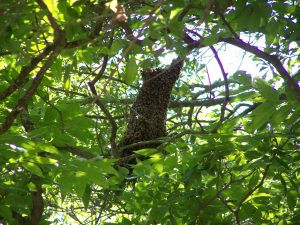
A “cloud of bees forming a swarm is a spectacular sight.” What happens in a honey bee swarm? When a colony grows to a certain size, new queens are reared in special large peanut-shaped queen cells and fed “royal jelly” (an enriched diet of brood food). Shortly before a new queen emerges, the old queen leaves the nest with about 10,000 to 20,000 (and maybe some male drones) and creates a new nest elsewhere. Worker honey bees prepare for swarming for many days. An obvious sign is the making of a queen cell or cup, created at the edge of a frame of comb. Another sign is the filling in of cells with honey, since the workers gorge themselves with honey preparing to leave with the old queen. Once the scout bees find a suitable nesting site, they prepare to leave the old nest or swarm. The honey bees where designed to reproduce themselves in this way. The bees may find a resting place on the way (see photo), but the scout bees will urge the swarm on to the final site. It takes only a few days for new usable comb to be created and the new nest established.
Back in the old hive, meanwhile, the new queens start to emerge from their wax cells. Only one queen normally lives in the nest so, as soon as the first queen is groomed and dried, she seeks out all the other queen cells on the comb, tears open the cells with her jaws and stings the other queens, queens larvae, and pupae to death. The new queen then leaves the nest on her “nuptial” flight. She seeks out clusters of drones that have previously congregated at treetops and other elevated places, where they have released special attractant pheromones (chemical scents). Once the males see the queen, they pursue her in a mating “swarm”. The mating flight lasts about 30 minutes and may travel over several miles. New studies in beekeeping see how very important the mating of many drones is for new queens to be successful in their laying and the colony survival.
If you see a swarm of honey bees, contact us or your nearest beekeeper, and the new colony can be collected, if accessible, and placed in a new home. Swarms normally happen in the Spring, but can continue through into July.
Notes taken from The Beekeeper’s Bible

